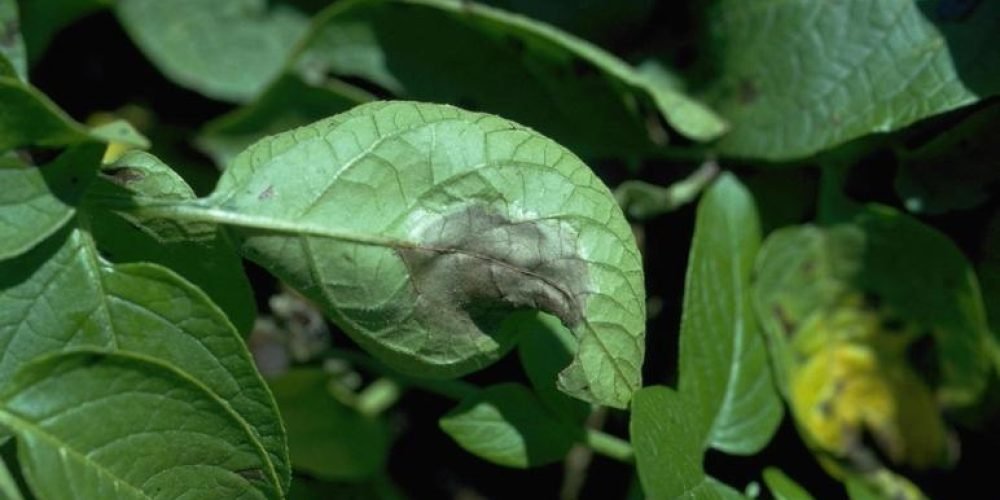Disease name: late blight of potatoes
Scientific name: Phytophthora infestans
Type of disease: Oomycete pathogen
Disease family: Pythiaceae
- introduction:
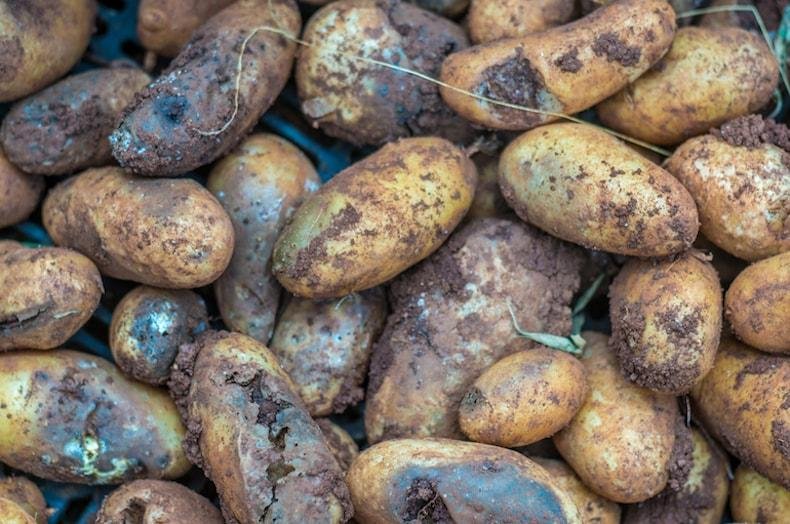
Potatoes (Solanum tuberosum) are vital to global food security and face major challenges due to diseases. Late blight, caused by the fungal pathogen Phytophthora infestans, is particularly notorious and belongs to the Pythiaceae family. Thanks to its historical importance, which contributed significantly to the Irish Potato Famine, late blight poses a serious threat to potato crops. This article explores the pathogen's life cycle, symptoms, causes, preferred conditions, and effective control strategies for the disease, providing insights for better management.
- life cycle:
Understanding the life cycle of Phytophthora infestans is crucial for developing effective management strategies. The pathogen lives mainly in infected tubers or plant residues after harvest. Sporangia are produced on infected plant tissue during the growing season, and are spread by air currents, rain or irrigation, resulting in infection near potato plants. Upon reaching a susceptible host, sporangia release zoospores, which swim across aqueous membranes to penetrate plant tissue. Rapid reproduction within the plant causes characteristic late blight symptoms. The cycle repeats as the pathogen produces more sporangia, completing the destructive cycle.
- Symptoms:
As late blight progresses, characteristic symptoms appear, including dark spots on the leaves that expand rapidly and appear with a scattered or mold-like appearance. Dark brown spots appear on the leaves, starting from the tip or edges of the leaf. In humid climates, these dots turn into mold-like discolorations and are saturated with water. A white, downy growth forms, which is a hallmark of Phytophthora infestans. As the disease progresses, entire leaves become necrotic, turn brown, and die. Similar pigmentation appears on the stems and petals. Potato tubers develop gray-blue spots on their skin, and the inside of the tuber also turns brown, making it inedible. It emits a distinctive odor when infected fields rot.
Late blight is often misunderstood as a fungus. However, it is an aomasite, a fungus- and algae-like organism. Mild conditions (15-25°C) and long periods of high humidity, as a result of rain and fog, can lead to late blight epidemics. Rain and fog can cause widespread disease, and potato fields can be severely damaged in just a few days or even destroyed in as little as two weeks. Symptoms of late blight include widespread brown to black discoloration on the leaves surrounded by a thin ring of light coloring. In high humidity conditions, a gray to white “lump” may appear around the edges of dark pigmentation.
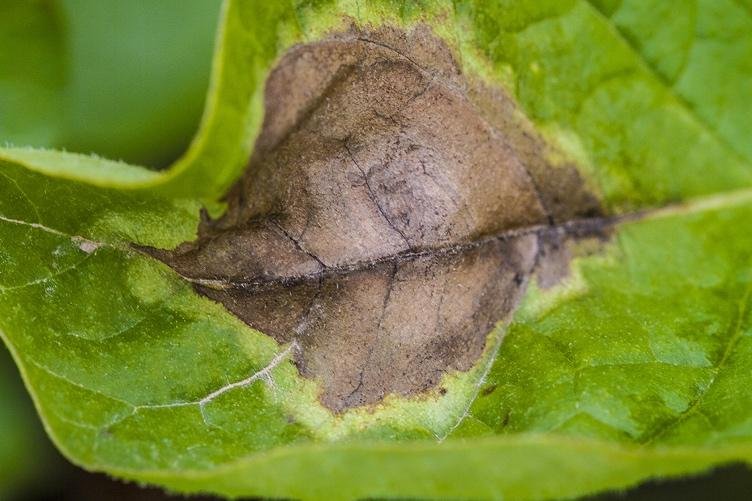
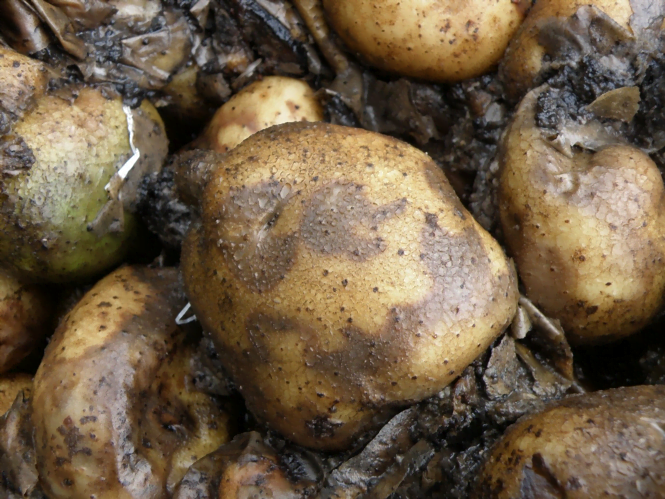
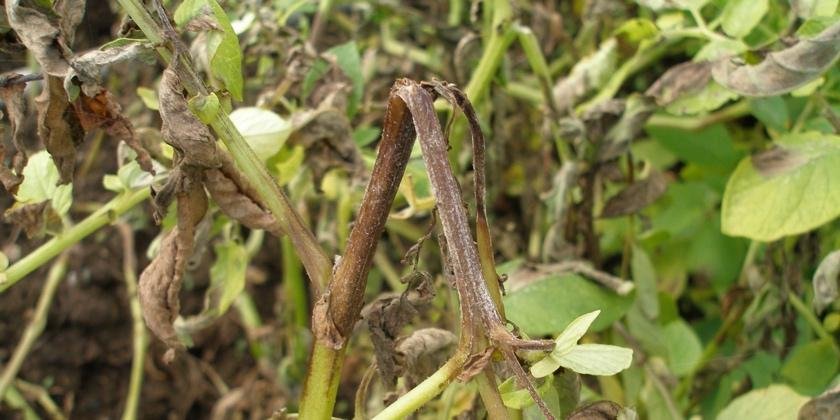
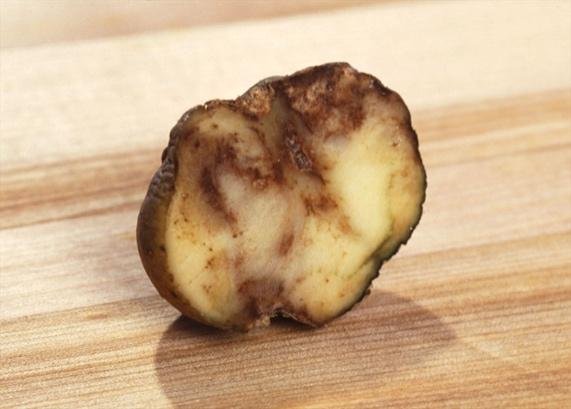
- The causes of disease:
The development of late blight as a powerful potato disease is due to five main factors. The high genetic diversity of the pathogen enables it to rapidly adapt to changes in environments and evolving resistance mechanisms. The continued presence of infected plant debris and tubers constitutes a primary source of infection for subsequent seasons. The global movement of tubers facilitates the spread of the pathogen over long distances, contributing to its widespread spread. The continuous development of new strains with more aggressive reaction and resistance to fungicides challenges traditional methods of control. Climate change, with unpredictable weather patterns, creates favorable conditions for the development of late blight, increasing challenges for potato growers.
- Conditions suitable for the spread of the disease:
Late blight thrives in conditions of high humidity and moderate temperatures, and the disease often spreads in late spring and early summer. Spores are spread via air currents, rain or irrigation, highlighting the importance of proper water management to prevent disease. Effective preventive measures in different environments, given the appropriate seasons for the spread of the disease, are essential to reduce risks and protect potato crops throughout their growth cycle.
- Losses from disease:
Late blight poses a serious threat to potato crops, potentially causing huge losses. The disease can lead to a decrease in production, affect tuber quality, and cause economic losses to potato growers.
- Control strategy:
Effective management of potato blight requires an integrated approach, combining chemical and organic practices.
– Agricultural practices: Implementing good agricultural practices such as crop rotation, proper spacing and timely harvesting reduces the risk of late blight on potatoes. Destroying infected plant residues after harvest reduces the possibility of harmful fungi remaining in the ground. Working with resistant plant varieties is essential, as not all potato varieties have the same level of resistance to late blight. The best thing to do as soon as possible is: Overcoming the infestation and successfully controlling potato late blight is easier and more efficient from its onset. Regular monitoring and inspection of plants for early detection of signs of late blight on potatoes on a weekly basis and introduction of mesh ventilation areas to improve air circulation are key measures of good agricultural practices.
– Chemical control: Fungicides play a crucial role in treating potato late blight, especially in humid areas. Copper-based and systemic fungicides such as chlorothalonil, cymoxanil and dimethomorph are commonly used. Strategic application can control the disease, but continued adoption may lead to the development of pesticide-resistant strains, highlighting the need for diversity. When conditions are suitable, it is preferable to spray fungicides at an interval of 5 to 7 days. It is recommended not to perform two consecutive iterations using the same active ingredients.
– Organic control: For those who prefer organic methods, biofungicides such as Bacillus thuringiensis, Trichoderma and Streptomyces can be incorporated into a sustainable, environmentally friendly management plan to control potato late blight. Additionally, neem oil applications have shown effectiveness against potato late blight. An integrated approach should always be considered with preventive measures combined with biological treatments if available. The use of fungicides is important to control late blight, especially in humid areas.
- Preventive measures:
Effective prevention is necessary to mitigate the risk of late blight spreading to potatoes. Protection of potato crops can be significantly enhanced by implementing a comprehensive set of measures. Here are the main preventive measures to consider:
- Use healthy tubers or hardier plants: Start with a strong foundation by choosing disease-free tubers or varieties with increased tolerance to potato late blight.
- Ensure good aeration and well-drained soil: Create an environment that prevents the development and spread of late blight on potatoes by promoting proper air ventilation and optimal soil drainage.
- Monitor the fields regularly and remove infected plants and those surrounding them: Thoroughly inspect fields on a regular basis to identify and remove any plants showing symptoms of potato blight. This proactive approach helps control the spread of the disease.
- Implementing rotation between non-disease host crops for a period of 2 to 3 years: Break the disease cycle by practicing a non-host crop rotation, switching to non-host crops for 2 to 3 years, reducing the availability of suitable hosts for the pathogen.
- Removal of hosts in the area surrounding the field: Eliminate any potential hosts around the field, reducing the risk of late blight recurring on potatoes.
- Avoid excessive nitrogen fertilization: Maintain a balanced approach to fertilization, as excessive nitrogen can create conditions that encourage potato late blight. Adopt recommended fertilization practices to promote healthy plant growth.
- Use of plant tonics: To enhance the natural defenses of potato plants against potato late blight, incorporating plant calendars or natural resistance stimulants may be considered.
- Store tubers at low temperatures and with good ventilationProper post-harvest storage is vital. Keep harvested tubers at low temperatures and ensure good ventilation to prevent the development of potato blight in storage.
- Destroying tubers and plant remains after harvest, burying them up to two feet deep or feeding them to animals: Dispose of harvested tubers and plant remains responsibly by burying them at least 2 feet deep or using them as animal food. This helps eliminate potential sites of the pathogen of winter late blight.
Adherence to these preventive measures collectively contributes to enhancing effective defense against potato late blight, thus protecting potato crops throughout their growth cycle. Vigilance, combined with these proactive measures, is key to reducing the impact of this persistent and devastating disease.
- Conclusion:
Late blight is a major global threat to potato production, capable of causing huge losses if not managed effectively. Vigilant surveillance, early detection, and integrated disease management strategies are indispensable. Collaboration between researchers, farmers and decision-makers is essential to stay ahead of this persistent and devastating disease, ensuring food security for a growing population.
Sources:
1. Fry, WE, Birch, PRJ, Judelson, HS, Grünwald, NJ, Danies, G., Everts, KL, … & Smart, CD (2015). Five reasons to consider Phytophthora infestans a reemerging pathogen. Phytopathology, 105(7), 966-981.
2. Haas, B.J., Kamoun, S., Zody, M.C., Jiang, R.H.Y., Handsaker, R.E., Cano, L.M., … & Birren, B.W. (2009). Genome sequence and analysis of the Irish potato famine pathogen Phytophthora infestans. Nature, 461(7262), 393-398.
3. Haverkort, AJ, Struik, PC, Visser, RGF, & Jacobsen, E. (2009). Applied biotechnology to combat late blight in potatoes caused by Phytophthora infestans. Potato Research, 52(3), 249-264.
4. Saville, A., Graham, K., Grünwald, N. J., Myers, K., Fry, W. E., & Ristaino, J. B. (2015). Fungicide sensitivity of US genotypes of Phytophthora infestans to six oomycete-targeted compounds. Plant Disease, 99(5), 659-666.
5. https://agrio.app/library/LateBlight/
6. https://plantix.net/en/library/plant-diseases/100040/potato-late-blight/
Photos:-
- https://upload.wikimedia.org/wikipedia/commons/a/aa/Late_blight_on_potato_leaf_2.jpg
- https://images.ctfassets.net/l2hapltrg3cz/1de7jGbvTz09CpuRdtC893/6d31965c7ddb550b1f04f2ab9a531ff0/late-blight.jpg
- https://www.openaccessgovernment.org/wp-content/uploads/2018/12/dreamstime_xxl_116012675.jpg
- https://www.agric.wa.gov.au/sites/gateway/files/Late%20blight%20tuber%20infection.jpg
- https://apps.lucidcentral.org/pppw_v10/images/entities/potato_late_blight_265/plbtuber.jpg
- https://www.thompson-morgan.com/static-images/tandm/static-articles/how-to-stop-potato-blight/harvest-blighted-potatoes-rot.jpg
